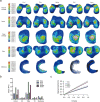The triply periodic minimal surface-based 3D printed engineering scaffold for meniscus function reconstruction
- PMID: 36115984
- PMCID: PMC9482755
- DOI: 10.1186/s40824-022-00293-3
The triply periodic minimal surface-based 3D printed engineering scaffold for meniscus function reconstruction
Abstract
Background: The meniscus injury is a common disease in the area of sports medicine. The main treatment for this disease is the pain relief, rather than the meniscal function recovery. It may lead to a poor prognosis and accelerate the progression of osteoarthritis. In this study, we designed a meniscal scaffold to achieve the purposes of meniscal function recovery and cartilage protection.
Methods: The meniscal scaffold was designed using the triply periodic minimal surface (TPMS) method. The scaffold was simulated as a three-dimensional (3D) intact knee model using a finite element analysis software to obtain the results of different mechanical tests. The mechanical properties were gained through the universal machine. Finally, an in vivo model was established to evaluate the effects of the TPMS-based meniscal scaffold on the cartilage protection. The radiography and histological examinations were performed to assess the cartilage and bony structures. Different regions of the regenerated meniscus were tested using the universal machine to assess the biomechanical functions.
Results: The TPMS-based meniscal scaffold with a larger volume fraction and a longer functional periodicity demonstrated a better mechanical performance, and the load transmission and stress distribution were closer to the native biomechanical environment. The radiographic images and histological results of the TPMS group exhibited a better performance in terms of cartilage protection than the grid group. The regenerated meniscus in the TPMS group also had similar mechanical properties to the native meniscus.
Conclusion: The TPMS method can affect the mechanical properties by adjusting the volume fraction and functional periodicity. The TPMS-based meniscal scaffold showed appropriate features for meniscal regeneration and cartilage protection.
Keywords: Cartilage protection; Mechanical properties; Meniscal scaffold; Triply periodic minimal surface.
© 2022. The Author(s).
Conflict of interest statement
None.
Figures








References
Grants and funding
LinkOut - more resources
Full Text Sources

